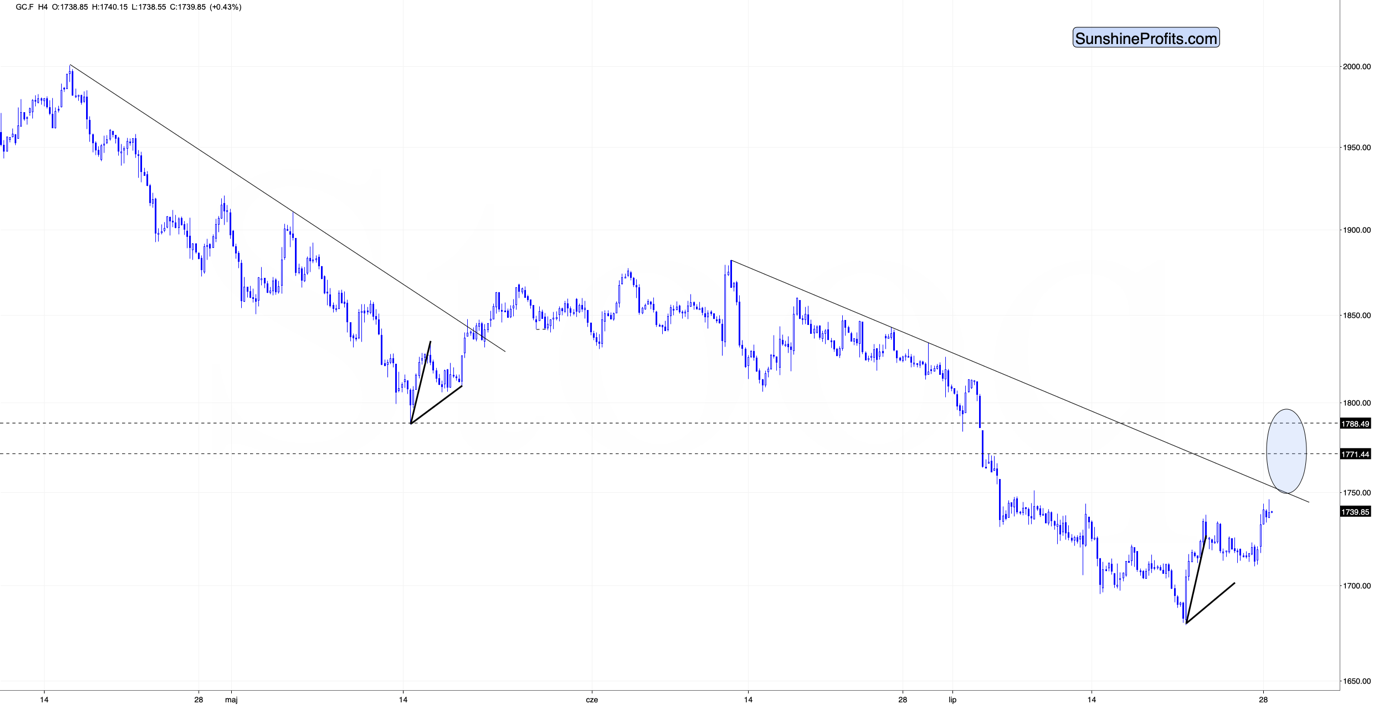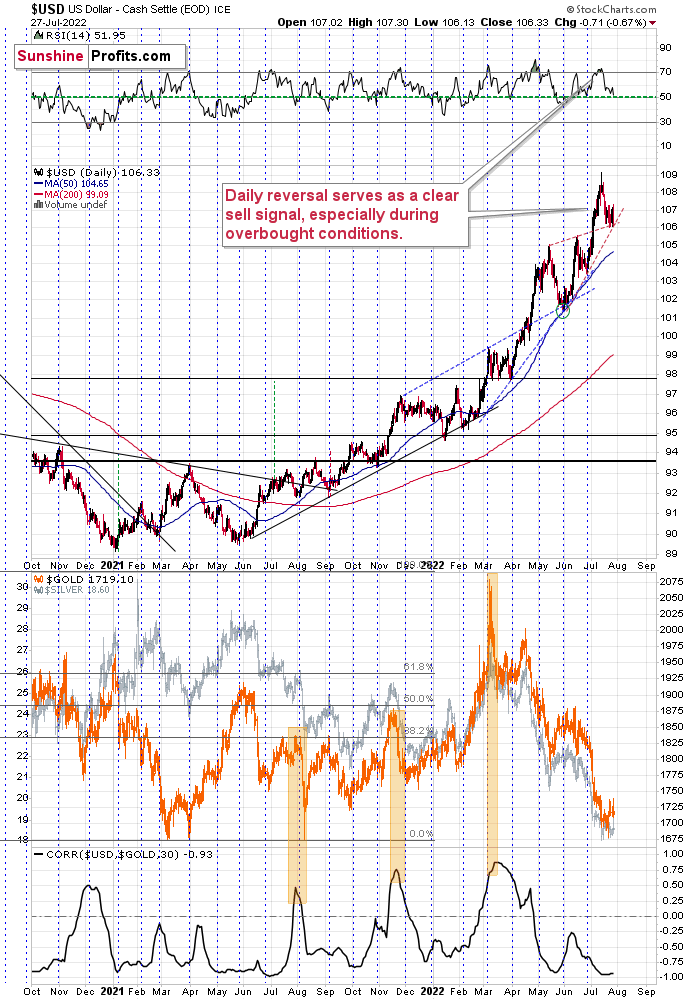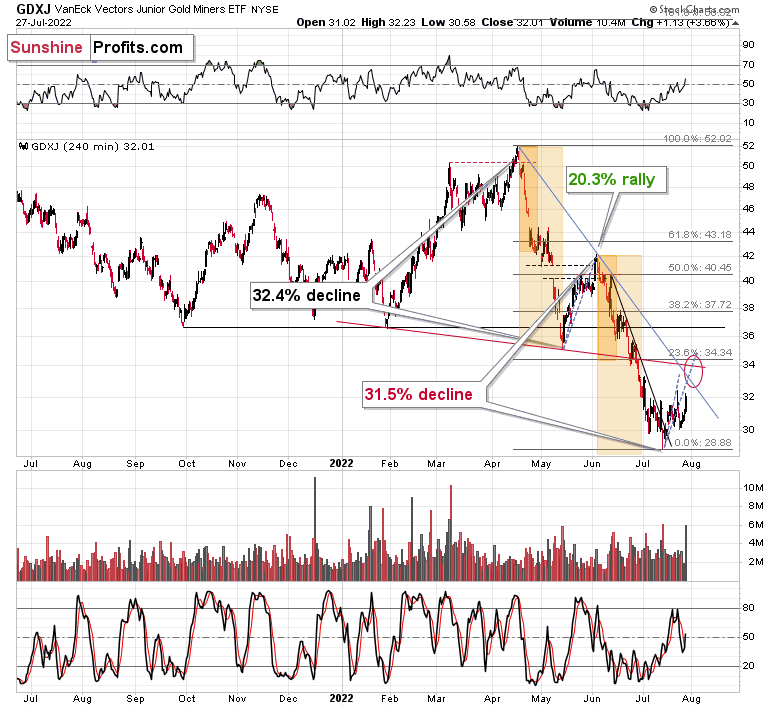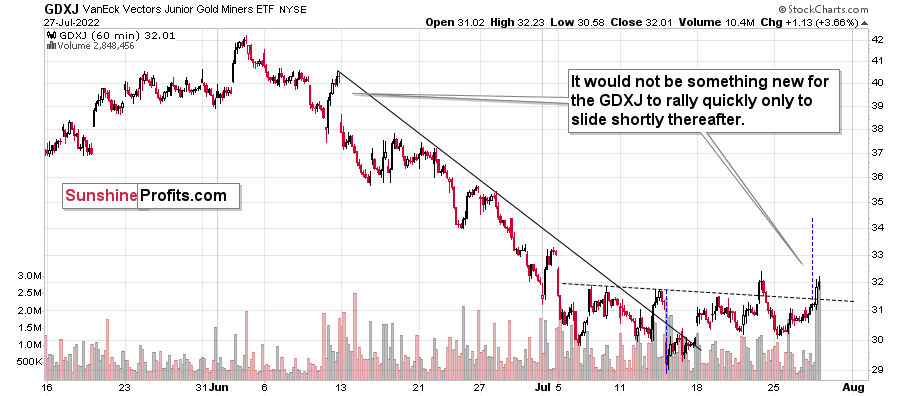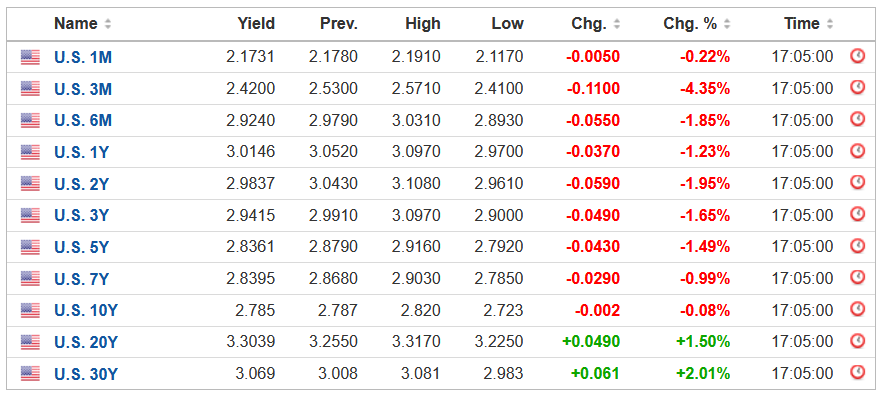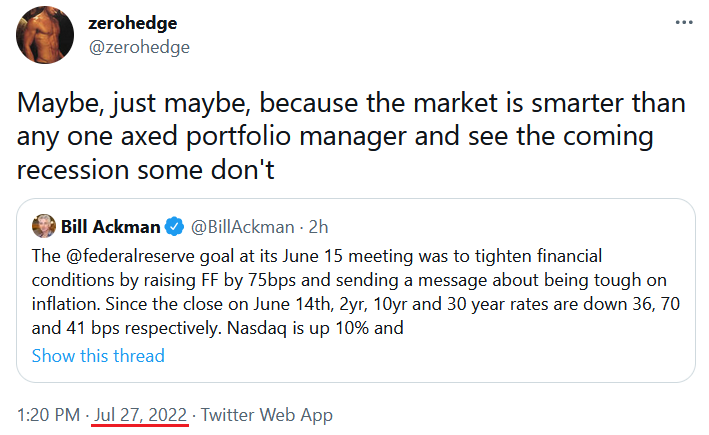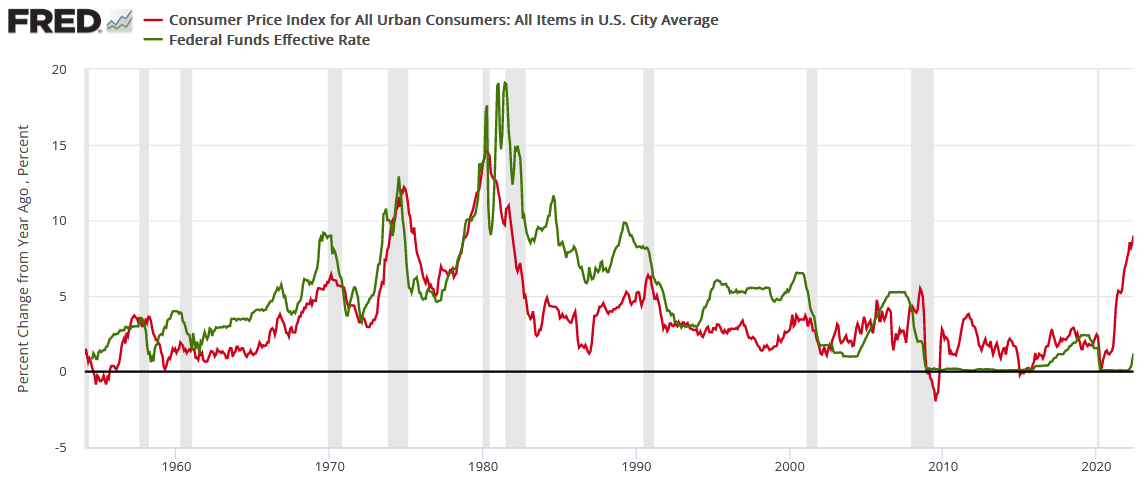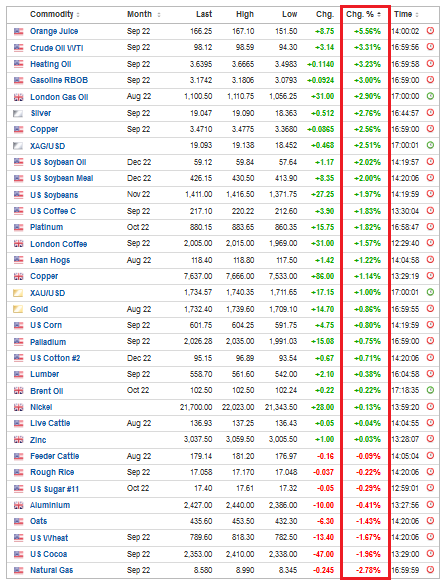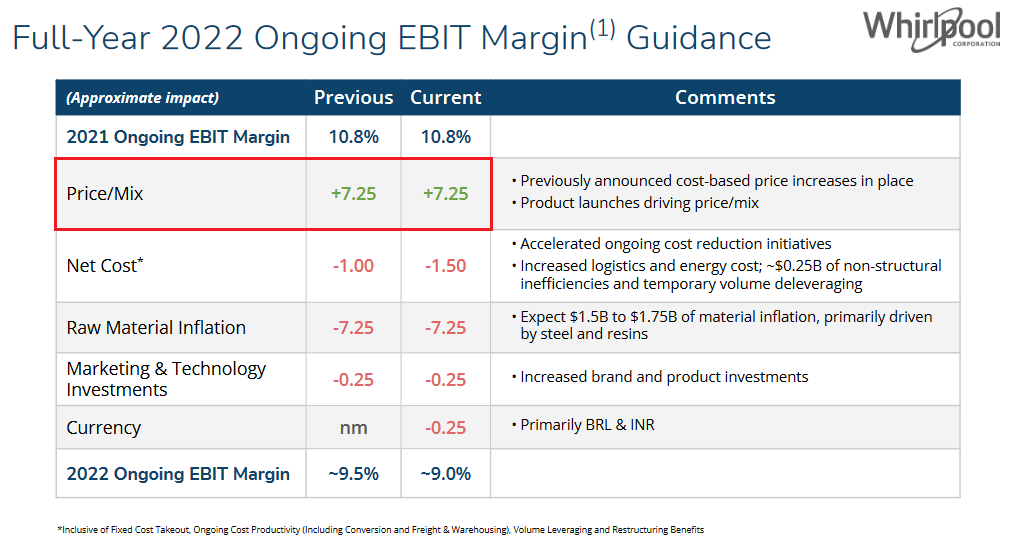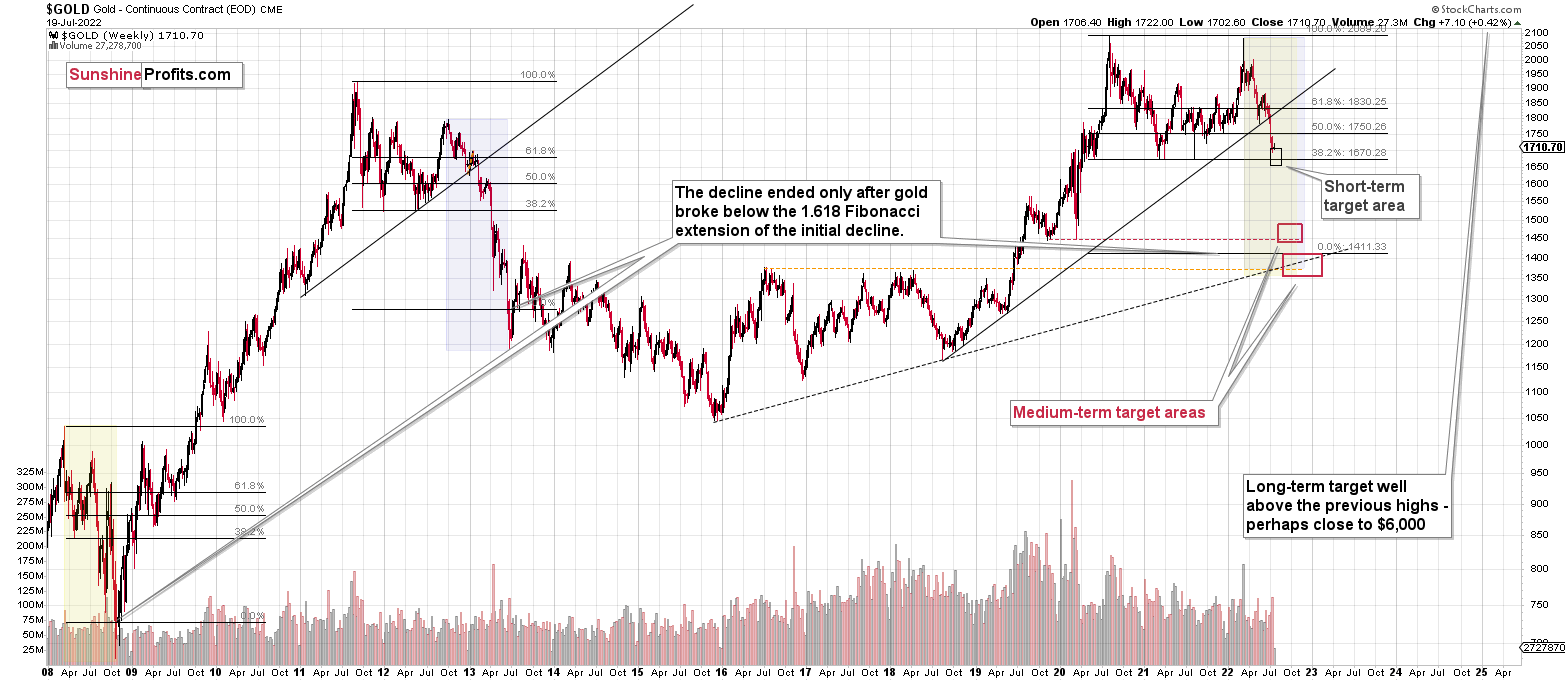Briefly: in our opinion, full (200% of the regular position size) speculative long positions in junior mining stocks are justified from the risk/reward point of view at the moment of publishing this Alert.
Told ya :)
The Fed raised interest rates and the narrative during the press conference was dovish, which was a bullish surprise for the markets and served as a direct trigger for yesterday’s (and today’s pre-market) upswings. This dovish phase is unlikely to last long, because it’s based on wishful comments, not on the hard facts, which continue to point to the necessity of hiking rates further.
This means that investors are likely to soon (perhaps as early as on Friday, when they get the Core PCE data) return to bear mode.
However, until that happens, we’re likely to see a rally. As a reminder, technicals forecasted this upswing well before yesterday, so it’s not that it was “just news-based”. Things are developing very much in tune with their previous patterns, and we don’t need to “wait and see” for what the Fed (or anyone else) does and then try to catch the move that unfolds in order to ride the market waves. We don’t even need to try to guess what they will say. Sure, it’s helpful and it does add a layer of clarity, but the self-similar patterns along with additional factors are the basis – the news is just the addition.
So, let’s see what happened on the charts yesterday and what’s taking place so far today, starting with gold’s chart.
In yesterday’s analysis, I commented on the above chart in the following way:
Based on the symmetry of how gold recently performed after a local bottom (sharp rally and then a correction), it seems that we’re on the verge of a sharp move higher.
The black lines that I marked on the above chart are identical – I copied the previous lines connecting the bottom with the following top and bottom, and I pasted them on the current situation, attaching them to the recent bottom. Interestingly, the timing of the recent immediate-term top and bottom aligns almost perfectly. This makes it quite likely that the follow-up action will also be similar.
Please note that just because the about-to-be-seen rally is likely to be sharp doesn’t mean that it’s likely to be a medium-term game-changer. To clarify, a $30-80 rally is what I think is likely to follow, nothing more. The $1,745-1,770 area seems to be the most reliable short-term target, in my view.
Indeed, what followed was a sharp move higher. If the analogy continues, we’re likely to see some immediate-term back-and-forth movement and then another daily or 2-day move higher.
In the case of the USD Index, we saw a decline, but not yet a move below the nearby support lines.
Did we just see the bottom? Perhaps, but there’s much stronger support at about 105 – the previous long-term price extreme and the 50-day moving average, so it seems quite likely that the USDX will decline until it reaches it.
The GDXJ ETF rallied on strong volume yesterday, which might indicate that those who were the most eager to buy just bought, and thus that the top might be close.
Still, since the short-term resistance lines were not reached yet, it seems that the GDXJ can rally further (thus increasing our profits on the current long positions) and top then. It wouldn’t surprise me to see the top form today or tomorrow. Stay tuned.
In yesterday’s analysis, I commented on GDXJ’s very short-term chart in the following way:
When we zoom in even more, we see that sudden upswings are not that uncommon in the case of junior miners.
We saw one in early June. If gold jumps higher on dovish remarks from the Fed, juniors would be likely to jump, too.
The resistance line based on the previous July highs could be viewed as the neck level of an inverse head-and-shoulders pattern, which – when broken – would support a rally to the $34-34.5 area.
Indeed, the neck level of the inverse head and shoulders pattern was broken, which makes another upswing likely.
So far, the GDXJ is up by over 4% in today’s London trading, so it’s quite likely that it will rally in the U.S. markets, too.
Naturally, if I see a good opportunity to take profits from our current long positions and re-enter the short positions, I’ll keep you – my subscribers – informed. The above might (it doesn’t have to, but it’s quite likely) take place today or tomorrow.
Having said that, let’s take a look at the markets from a more fundamental point of view.
Powell Strikes Again
With all eyes on Fed Chairman Jerome Powell on Jul. 27, the central bank chief took his perpetually dovish rhetoric to a new 2022 high. Moreover, while the FOMC raised interest rates by 75 basis points – which was widely expected – Powell was Mr. Friendly. He said:
“While another unusually large increase could be appropriate at our next meeting that is a decision that will depend on the data we get between now and then (...). As the stance of monetary policy tightens further, it will likely become appropriate to slow the pace of increases while we assess how our cumulative policy adjustments are affecting the economy and inflation.”
He added:
"Recent indicators of spending and production have softened. Nonetheless, job gains have been robust in recent months, and the unemployment rate has remained low."
Thus, while Powell reiterated comments like ‘rate hikes will continue’ and ‘we’re dedicated to achieving our 2% inflation goal,’ he continued to demonstrate his lack of inflation understanding. For example, he noted that “the public doesn’t distinguish between headline and core inflation,” and that a sustained period of supply shocks caused by bottlenecks and the pandemic “can start to undermine and work on de-anchoring inflation expectations.”
Therefore, he still assumes that inflation is mainly a supply-side phenomenon and that the Fed has to balance both sides of the equation delicately. However, while his uniformed assessment will likely be his undoing, the rhetoric is bullish for our GDXJ ETF long position.
Please see below:
To explain, the gold line above tracks the one-minute movement of the GDXJ ETF, while the red line above tracks the one-minute movement of the USD Index. If you analyze the vertical gray line, you can see that volatility struck when Powell began his press conference at 2:30 p.m. ET.
Moreover, with his dovish disposition sinking the dollar basket and uplifting the junior miners, the price action unfolded as expected. To explain, I wrote before the opening:
With Powell taking center stage today, intraday volatility may be amplified. However, with risk assets often rallying during Powell’s pressers, another re-enactment would help our long position. Moreover, if he decides to talk down the USD Index and U.S. Treasury yields, it would only brighten the GDXJ ETF’s short-term outlook. As such, while unanchored inflation should shift sentiment over the medium term, we still expect higher prices in the days ahead.
To that point, with Powell making it a trifecta and also talking down U.S. Treasury yields, the central bank chief made it his mission to loosen financial conditions.
Please see below:
Thus, while Powell’s monetary missteps have been on display for 24+ months, he continues to repeat the same blunders. However, with the old Wall Street adage of ‘take what the market gives you’ proving prescient on Jul. 27, we don’t mind being long the GDXJ ETF and profiting from the short-term sugar high. Therefore, we expect the junior miners’ uprising to continue in the days ahead.
In contrast, with Powell’s preference for patience poised to prove extremely costly over the medium term, we’ll be careful not to overstay our welcome.
Powell’s Freight Train to Ruin
While Powell’s dovish rhetoric was met with applause on Jul. 27, his willingness to push up asset prices and loosen financial conditions is like offering needles to drug addicts. In a nutshell: he provides what they want, not what they need. Therefore, while sentiment moves markets and the current environment is bullish for the GDXJ ETF, the medium-term consequences should be dire.
For example, I’ve noted how billionaire hedge fund manager Bill Ackman aligns with our way of thinking about inflation. However, with our view in the extreme minority, the consensus sees things overwhelmingly differently. Moreover, Ackman was spot on when he wrote on Jul. 26 that “the biggest risk to the U.S. economy is not the Fed raising rates. It is inflation.”
Furthermore, while he referenced the sharp drop in U.S. Treasury yields, the drop in investment grade and high yield credit spreads, and the rise in stock prices, (add the USD Index decline, though Ackman didn’t mention that), he noted prior to the FOMC release on Jul. 27 that “financial conditions have eased materially, which has made the inflation problem worse.”
He added:
“What I don’t understand is why Powell is reluctant to say that the Fed will stop inflation in its tracks by raising rates and keeping them as high as they need to be for as long as they need to be until we have durable evidence (not a few months of lower inflation) that inflation has been licked. That is what it is going to take to kill off inflation and preserve the economy and the equity markets for the long term.”
Thus, while Ackman should know that Powell always leans dovish during his press conferences, the six-to-12-month assessment should prove prescient. However, since opponents of the thesis believe that “the market is smarter,” the consensus (for some reason) opines that rampant inflation is preferable to a rate-hike-induced recession.
Please see below:
However, I warned on May 20 that investors should be careful what they wish for. I wrote:
With the consensus still fighting the hawkish realities that I warned about since 2021, the VIX is behaving as you might expect. I mean, why panic when the Fed is all bark and no bite? Therefore, everyone can relax because the Fed will turn dovish, inflation will rage, and in some alternative reality, this outcome is bullish for risk assets.
However, I’ve warned on numerous occasions that a dovish pivot would have dire long-term consequences for the U.S. economy. As such, Fed officials (should) know this, and a small short-term recession is much more attractive than a long-term hyperinflationary collapse. Yet, investors still assume that the latter option is more likely because the Fed can’t withstand falling stock prices.
However, with recency bias clouding investors’ judgment, they don’t realize that 1970s/1980s-like inflation is a completely different animal.
Thus, while the consensus follows the post-GFC ‘bad news is good news’ script and assumes that weak data will elicit a Fed pivot that solves all of the U.S.’s economic problems, the reality is that the recession train has already left the station.
As a result, the choice is between a rate-hike-induced downturn that quells inflation or a hyperinflationary malaise that leaves Americans in a worse position 12 months from now. Likewise, if investors assume that cutting rates or reigniting QE amid rampant inflation will have a positive outcome, they haven’t done their homework. As evidence, I warned on May 26 that the consensus is betting on an outcome that hasn’t materialized in 70+ years. I wrote:
With annualized inflation at [9%+], calming the price pressures with such little action is completely unrealistic. In fact, it’s never happened.
If you analyze the chart below, you can see that the U.S. federal funds rate (the green line) always rises above the year-over-year (YoY) percentage change in the headline Consumer Price Index (the red line) to curb inflation. Therefore, investors are kidding themselves if they think the Fed is about to re-write history.
In addition, notice how every inflation spike leads to a higher U.S. federal funds rate and then a recession (the vertical gray bars)? As such, do you really think this time is different?
What Inflation?
With Powell noting that the pace of future rate hikes will "depend on the data," his rhetoric was a green light for risk assets. However, with crude oil prices rallying sharply, most commodities took note of the dovish pushback. As such, Powell's words fueled month-over-month (MoM) inflation.
Please see below:
Likewise, while Q2 earnings calls and presentations have been riddled with mentions of inflation and price increases, the chorus continues to sing. For example, Whirlpool – a U.S. manufacturer of home appliances like dishwashers, fridges, ovens, and laundry equipment – released its second-quarter earnings on Jul. 26. CFO James Peters said during the Q2 earnings call:
“Our raw material inflation expectations remain unchanged, and we do expect raw material inflation to peak in the second and third quarter.” However, with higher prices “fully offsetting cost inflation,” price increases of 7.25% are expected for the remainder of 2022.
Please see below:
In addition, I noted on Jul. 27 that Chipotle Mexican Grill was a major winner after hours due to upbeat earnings. However, with price increases the primary culprit, investors responded positively to the company’s ability to protect its profit margins. An analyst asked during the Q2 earnings call, “Why seek more pricing now?” CEO Brian Niccol responded:
“Unfortunately, a lot of things have stuck versus gone away as far as inflation. And then we’ve got some key items that have frankly continued to be inflationary. And I think Jack highlighted it right. We’ve got avocados, we’ve got dairy, tortillas, some packaging. So, unfortunately, we were hoping we’d see some of the stuff pull back. We haven’t seen that.”
Moreover, when asked about construction costs for new stores, CFO John Hartung responded:
“In terms of inflation, it’s at least in the several percent range, maybe even more than that. The deals have varied throughout the country, but definitely our investment costs this year are much higher than they have been in the past and higher than we expected them to be.”
As a result, after raising prices by ~10% in the back half of 2021, another ~4% increase is scheduled for August.
Please see below:
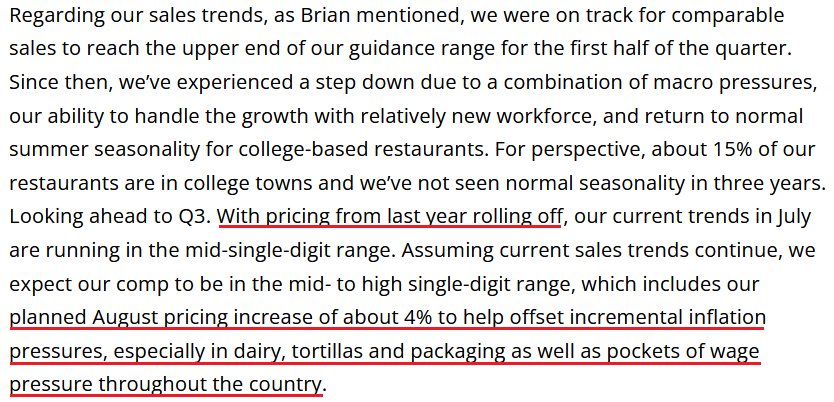 Source: Chipotle Mexican Grill/AlphaStreet
Source: Chipotle Mexican Grill/AlphaStreet
Thus, Powell is flying blind once again. After raising prices for 24+ months, corporations continue to amplify inflation. Moreover, it’s Powell’s responsibility to normalize the pricing pressures, and corporations will do what they have to do to preserve their margins and keep their stock prices afloat. As such, Powell drastically underestimates the task at hand.
The Bottom Line
Since Powell’s lack of foresight is a gift to our GDXJ ETF long position, we think the upward momentum still has some room to run. Moreover, with the USD Index and the U.S. 10-Year real yield falling, looser financial conditions are bullish for junior miners. However, a reversal of fortunes should occur rather sooner than later (probably not later than a week from today).
In conclusion, the PMs rallied on Jul. 27, as it was off to the races for risk assets. Moreover, with the bulls exuding confidence, higher prices remain the path of least resistance. As a result, we remain on the long side for the time being, and profitably so.
Overview of the Upcoming Part of the Decline
- It seems to me that we’re going to see a corrective upswing here (probably ending in the final week of July or very early August) that will then be followed by a very big decline in the precious metals sector.
- If we see a situation where miners slide in a meaningful and volatile way while silver doesn’t (it just declines moderately), I plan to – once again – switch from short positions in miners to short positions in silver. At this time, it’s too early to say at what price levels this could take place and if we get this kind of opportunity at all – perhaps with gold prices close to $1,600.
- I plan to exit all remaining short positions once gold shows substantial strength relative to the USD Index while the latter is still rallying. This may be the case with gold close to $1,400. I expect silver to fall the hardest in the final part of the move. This moment (when gold performs very strongly against the rallying USD and miners are strong relative to gold after its substantial decline) is likely to be the best entry point for long-term investments, in my view. This can also happen with gold close to $1,400, but at the moment it’s too early to say with certainty.
- The above is based on the information available today, and it might change in the following days/weeks.
You will find my general overview of the outlook for gold on the chart below:
Please note that the above timing details are relatively broad and “for general overview only” – so that you know more or less what I think and how volatile I think the moves are likely to be – on an approximate basis. These time targets are not binding nor clear enough for me to think that they should be used for purchasing options, warrants, or similar instruments.
Summary
Summing up, it seems that while the medium-term trend in the precious metals sector remains down, we are currently experiencing a corrective upswing.
In my opinion, the GDXJ will most likely move higher and top sometime this week – perhaps today or tomorrow – or early next week.
It seems likely that the profits that we earned from the last couple of trades will increase even further in the near future.
After the final sell-off (that takes gold to about $1,350-$1,500), I expect the precious metals to rally significantly. The final part of the decline might take as little as 1-5 weeks, so it's important to stay alert to any changes.
As always, we'll keep you – our subscribers – informed.
To summarize:
Trading capital (supplementary part of the portfolio; our opinion): Full speculative long positions (200% of the full position) in junior mining stocks are justified from the risk to reward point of view with the following binding exit profit-take price levels:
Mining stocks (price levels for the GDXJ ETF): binding profit-take exit price: $33.87; stop-loss: none (the volatility is too big to justify a stop-loss order in case of this particular trade)
Alternatively, if one seeks leverage, we’re providing the binding profit-take levels for the JNUG (2x leveraged). The binding profit-take level for the JNUG: $36.78; stop-loss for the JNUG: none (the volatility is too big to justify a SL order in case of this particular trade).
For-your-information targets (our opinion; we continue to think that mining stocks are the preferred way of taking advantage of the upcoming price move, but if for whatever reason one wants / has to use silver or gold for this trade, we are providing the details anyway.):
Silver futures upside profit-take exit price: $20.28
SLV profit-take exit price: $18.78
AGQ profit-take exit price: $24.57
Gold futures upside profit-take exit price: $1,776
HGU.TO – alternative (Canadian) 2x leveraged gold stocks ETF – the upside profit-take exit price: $13.46
HZU.TO – alternative (Canadian) 2x leveraged silver ETF – the upside profit-take exit price: $9.18
Long-term capital (core part of the portfolio; our opinion): No positions (in other words: cash)
Insurance capital (core part of the portfolio; our opinion): Full position
Whether you’ve already subscribed or not, we encourage you to find out how to make the most of our alerts and read our replies to the most common alert-and-gold-trading-related-questions.
Please note that we describe the situation for the day that the alert is posted in the trading section. In other words, if we are writing about a speculative position, it means that it is up-to-date on the day it was posted. We are also featuring the initial target prices to decide whether keeping a position on a given day is in tune with your approach (some moves are too small for medium-term traders, and some might appear too big for day-traders).
Additionally, you might want to read why our stop-loss orders are usually relatively far from the current price.
Please note that a full position doesn't mean using all of the capital for a given trade. You will find details on our thoughts on gold portfolio structuring in the Key Insights section on our website.
As a reminder - "initial target price" means exactly that - an "initial" one. It's not a price level at which we suggest closing positions. If this becomes the case (as it did in the previous trade), we will refer to these levels as levels of exit orders (exactly as we've done previously). Stop-loss levels, however, are naturally not "initial", but something that, in our opinion, might be entered as an order.
Since it is impossible to synchronize target prices and stop-loss levels for all the ETFs and ETNs with the main markets that we provide these levels for (gold, silver and mining stocks - the GDX ETF), the stop-loss levels and target prices for other ETNs and ETF (among other: UGL, GLL, AGQ, ZSL, NUGT, DUST, JNUG, JDST) are provided as supplementary, and not as "final". This means that if a stop-loss or a target level is reached for any of the "additional instruments" (GLL for instance), but not for the "main instrument" (gold in this case), we will view positions in both gold and GLL as still open and the stop-loss for GLL would have to be moved lower. On the other hand, if gold moves to a stop-loss level but GLL doesn't, then we will view both positions (in gold and GLL) as closed. In other words, since it's not possible to be 100% certain that each related instrument moves to a given level when the underlying instrument does, we can't provide levels that would be binding. The levels that we do provide are our best estimate of the levels that will correspond to the levels in the underlying assets, but it will be the underlying assets that one will need to focus on regarding the signs pointing to closing a given position or keeping it open. We might adjust the levels in the "additional instruments" without adjusting the levels in the "main instruments", which will simply mean that we have improved our estimation of these levels, not that we changed our outlook on the markets. We are already working on a tool that would update these levels daily for the most popular ETFs, ETNs and individual mining stocks.
Our preferred ways to invest in and to trade gold along with the reasoning can be found in the how to buy gold section. Furthermore, our preferred ETFs and ETNs can be found in our Gold & Silver ETF Ranking.
As a reminder, Gold & Silver Trading Alerts are posted before or on each trading day (we usually post them before the opening bell, but we don't promise doing that each day). If there's anything urgent, we will send you an additional small alert before posting the main one.
Thank you.
Przemyslaw Radomski, CFA
Founder, Editor-in-chief


